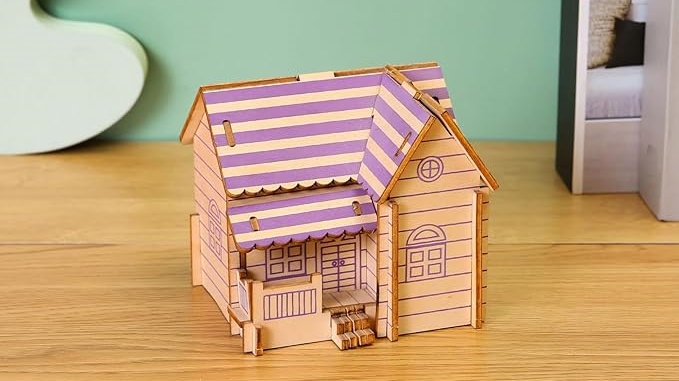
How To Add Storylines To Your Wooden Jigsaw Puzzle: A Creative Guide
Imagine a wooden jigsaw puzzle where each piece is more than a part of an image; it’s a chapter in a captivating story waiting to

Every wooden cube puzzle enthusiast knows the disappointment of picking up their favorite puzzle, only to find it damp or, worse, moldy. Not only does this affect the puzzle’s functionality, but it can also detract from its aesthetic appeal.
In this comprehensive guide, we’ll explore the causes of moisture and mold in wooden puzzles and outline practical steps to prevent these issues.
Ensuring your puzzle remains in excellent condition requires a bit of knowledge and effort, but it’s well worth it for the longevity and enjoyment of your puzzle.
Wood’s natural properties and environmental factors play significant roles in the moisture and mold issues that often plague wooden puzzles.
By understanding these underlying causes, we can better protect our cherished puzzles from damage.
Wood’s hygroscopic nature means it absorbs moisture from its environment, which can lead to swelling, warping, or even mold growth.
This is particularly problematic for wooden cube puzzles, as even slight changes in the wood can affect the puzzle’s integrity and the ease with which its pieces fit together.
To mitigate these effects, it’s crucial to control the environment around your puzzle, keeping it as dry and stable as possible.
Regularly monitoring the puzzle for signs of moisture, such as a musty smell or a change in the wood’s color, can help you take early action to protect it.
The environment surrounding your wooden cube puzzle significantly impacts its susceptibility to moisture and mold.
High humidity levels, particularly in areas without adequate airflow, create the perfect conditions for mold to thrive.
Temperature fluctuations can also contribute to the problem, as they can cause wood to expand and contract, further absorbing moisture.
Understanding these factors is the first step in creating a suitable environment for storing your puzzles. Keeping puzzles away from windows where direct sunlight can cause temperature spikes, and using air conditioners or fans to promote air circulation, can also help.

Taking proactive steps to prevent moisture accumulation and mold growth is essential for the longevity of your wooden cube puzzle.
These measures can help ensure that your puzzle remains in perfect condition, ready for your next solving session.
The simplest and most effective way to protect your wooden cube puzzle from moisture and mold is to keep it dry.
Using dehumidifiers in humid climates or during damp seasons can significantly reduce the risk of moisture damage.
Additionally, avoiding areas known for moisture accumulation, such as basements or bathrooms, when storing your puzzle can help maintain its condition.
It’s also beneficial to periodically check the area around where the puzzle is stored to ensure that it remains dry and well-ventilated.
Storing your wooden cube puzzle properly is vital for its preservation. Avoid sealing it in plastic bags, which can trap moisture and create a microenvironment ripe for mold growth.
Instead, opt for breathable storage solutions, such as cloth bags or wooden boxes with ventilation holes. Including silica gel packets in your storage container can also help absorb any excess moisture, keeping your puzzle dry.

This approach not only prevents moisture but also allows the wood to “breathe,” reducing the risk of mold development.
Regularly cleaning your wooden cube puzzle not only keeps it looking great but also prevents mold spores from taking root.
A dry, soft cloth can be used to wipe down the puzzle, removing dust and potential mold spores.
If you need to use a cleaner, choose one that’s safe for wood and avoid soaking the puzzle, as excessive moisture can lead to swelling and warping.
For more stubborn dirt, a slightly damp cloth can be used, followed by immediate drying with a soft, dry cloth to ensure no moisture remains on the surface.

Creating an optimal environment for your wooden cube puzzle involves monitoring and adjusting the temperature and humidity levels in your home.
Using a hygrometer to keep track of these conditions can help you make the necessary adjustments to protect your puzzle. Ensuring good ventilation can also prevent stagnant air, which is conducive to mold growth.
This might include opening windows during dry, sunny days to allow fresh air to circulate and using exhaust fans in areas like the kitchen and bathroom to remove excess moisture from the air.
If your puzzle has already succumbed to moisture or mold, all is not lost. With careful cleaning and drying, you can restore your puzzle to its former glory.
Being able to identify the early signs of mold on your wooden cube puzzle is crucial for its preservation. Look out for any discoloration, musty odors, or visible mold growth.
Early detection makes cleaning easier and prevents the mold from spreading further into the wood.
Regular inspections, especially during humid seasons, can help you catch and address mold growth before it becomes a significant problem.
If mold is found on your wooden cube puzzle, it’s important to clean and disinfect it promptly to prevent further damage. Using a mild, wood-safe cleaner, gently scrub the affected areas.
Rinse the area with a slightly damp cloth to remove any soap residue, and dry the puzzle thoroughly to ensure no moisture is left behind.
For disinfecting, a solution to vinegar and water can be lightly applied to the affected areas, as vinegar has natural antifungal properties that can help kill mold spores without damaging the wood.
Properly drying your wooden cube puzzle after cleaning is critical to preventing future mold growth. Allow the puzzle to air dry in a well-ventilated area, away from direct sunlight, which can cause the wood to fade or crack.
Once dry, your puzzle should be ready for use again, free from mold and moisture. If the wood appears dry and brittle after cleaning, a small amount of wood conditioner can be applied to restore its luster and protect it from future moisture damage.
Maintaining a wooden cube puzzle in good condition doesn’t have to be a daunting task.
By understanding the causes of moisture and mold and implementing preventative measures, you can keep your puzzle safe from harm.
Regular maintenance, proper storage, and controlling environmental conditions are key to preserving your puzzle’s beauty and functionality.
With these tips, your wooden cube puzzle will remain a cherished part of your collection for years to come, ready to challenge and delight you at every turn.
Can I use essential oils to clean my wooden cube puzzle?
While essential oils can add a pleasant aroma and some natural cleaning properties, they should be used with caution on wooden puzzles. Some oils can be too harsh for the wood, potentially damaging the finish or causing the wood to become more susceptible to moisture absorption. If you wish to use essential oils, opt for a very diluted solution and test it on a small, inconspicuous area of the puzzle first.
How often should I inspect my wooden cube puzzle for signs of moisture or mold?
We recommend inspecting your puzzle every 3 to 6 months, especially if you live in a humid climate or during seasonal changes when humidity levels can fluctuate. Regular inspections can help you catch any issues early on, making them easier to address before they cause significant damage.
Is it necessary to use a dehumidifier all year round to protect my puzzle?
The need for a dehumidifier depends on the climate you live in and the seasonal variations in humidity levels. In areas with consistently high humidity, using a dehumidifier year-round can help protect your wooden cube puzzle. However, in climates where humidity levels drop significantly during certain seasons, you may only need to use a dehumidifier during the more humid months.
Can I display my wooden cube puzzle in an open area, like a living room or office?
Displaying your puzzle in an open area is fine as long as you consider environmental factors such as direct sunlight, humidity, and temperature fluctuations. Avoid placing it near windows where it can be exposed to sunlight or in areas prone to moisture, like near kitchens or bathrooms. Using a display case with a glass front can provide an additional layer of protection while still allowing you to showcase your puzzle.
What should I do if the pieces of my wooden cube puzzle start to fit too tightly or too loosely after cleaning?
Fluctuations in fitting can occur due to changes in the wood’s moisture content. If the pieces fit too tightly, gently sanding the edges with fine-grit sandpaper can help. If they become too loose, applying a thin layer of wood conditioner or wax to the puzzle pieces can help restore some of the tightness. Always proceed with caution and test in a small area first to ensure you don’t further damage the puzzle.


Imagine a wooden jigsaw puzzle where each piece is more than a part of an image; it’s a chapter in a captivating story waiting to

When choosing the right puzzle box(wooden puzzle boxes or paper one) for your toddler, it’s essential to consider the materials’ properties and how they align

Embark on a journey to unravel the nuanced distinctions between two beloved genres of puzzles: plain wooden puzzles and 3d wooden puzzles. In this comprehensive

Imagine your wooden jigsaw puzzle not just as a piece to be solved but as an interactive journey that engages all your senses. This guide

Imagine a wooden jigsaw puzzle where each piece is more than a part of an image; it’s a chapter in a captivating story waiting to

When choosing the right puzzle box(wooden puzzle boxes or paper one) for your toddler, it’s essential to consider the materials’ properties and how they align

Embark on a journey to unravel the nuanced distinctions between two beloved genres of puzzles: plain wooden puzzles and 3d wooden puzzles. In this comprehensive

Imagine your wooden jigsaw puzzle not just as a piece to be solved but as an interactive journey that engages all your senses. This guide
Copyright © 2024 woodcraft3dpuzzles. All Rights Reserved.